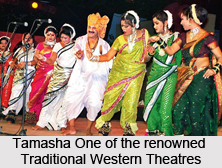Traditional Theatre in Western India is an integral part of Traditional Indian theatre became an expression to reflect the unedited realities of life in the most expressive way. Although Indian theatre has its roots associated deeply with the verve of the ancient Vedic era ritualism yet it is in the medieval era with the introduction of the Traditional Indian Theatre, Indian drama further gained that maturity. For the very first time the varied Indian mythology and eposes of the Sanskrit theatre was rather rationalised. Gradually this established facet of Indian traditional theatre gained a coloured contour amidst the local and Indian folk theatre.
 Traditional Theatre of Maharashtra
Traditional Theatre of Maharashtra
Tamasha is a traditional folk theatre form of Maharashtra. It has evolved from the folk forms such as Gondhal, Jagran and Kirtan. In Tamasha the female actress is the chief exponent of dance movements in the play which is unlike the other theatrical forms. Classical music and vivid gestures make it possible to depict all the emotions through dance. Tamasha is a form of theatre, which came into existence in the early 16th century in Maharashtra, which includes the love songs i.e. `Lavanis` due to which, this folk art, was very popular among the common people. Not only during its inception, but even today Tamasha happen to be one of the most awaited folk performances in the Indian state of Maharashtra. Tamasha includes songs and dance along with the musical instruments like the Dholki drum, `Tuntuni` (a single string instrument), `Manjira` cymbals, `Daf` (a tambourine-like instrument with a single leather surface), `Halgi` (smaller Daf), the metal triangle called `Kade`, the `Lejim` (an instrument with a jangling sound), the Harmonium and `Ghunghroos` (ankle bells). Tamasha is associated and performed with two of the communities of Maharashtra, viz: Kolhati and Mahar.
Tamasha can be performed, anywhere, without the construction of any special stage like the village square, the courtyard of any house, an open ground or even on an artificial stage. The overwhelming performance begins with the entry of the musicians as in the other dance-drama forms. At the beginning two percussionists named the dholkiwala and the Halgiwala enter in the scene. Here, while the dholkiwala provides the basic rhythm by playing the usual metrical cycles on the dholak, the Halgi provides the sharp accents and other piercing sounds, which add up as the musical background of Tamasha. The musical compositions of the Tamasha have a simultaneous use of the Raga and the incorporation of many folk and indigenous melodies. Amongst the Hindustani Ragas used for Tamasha Yaman, Bhairavi, and Pilu are common.
Traditional Theatre of Goa
Dashavatar is the most developed theatre form of the Konkan and Goa regions. The performers embody the ten incarnations of Lord Vishnu, the God of preservation and creativity. The ten incarnations of Lord Vishnu are Matsya (fish), Kurma (tortoise), Varaha (boar), Narsimha (lion-man), Vaman (dwarf), Parashuram, Lord Rama, Lord Krishna (or Balarama), Lord Budha and Kalki. Apart from stylised make-up, the Dashavatar performers wear masks of wood and papier mache. Krishnattam, folk theatre of Kerala, came into existence in the middle of 17th century A.D. under the patronage of King Manavada of Kolikod. This theatrical form is a cycle of eight plays performed for eight consecutive days. The plays are Avataram, Swayamvaram, Kaliamandana, Rasa krida, kamasavadha, Bana Yudham, Vivida Vadham, and Swargarohana. The episodes are based on the theme of Lord Krishna, his birth, childhood and different deeds illustrating the victory of good over evil.
Konkani "tiatr" is one of the traditional forms of Indian theatre for its high entertainment value, and is unique to Goa. On the regular stages it is performed as a Konkani play that even includes songs which are inherent to the play. A tiatr generally lasts for hours and usually has songs and 7 acts of barely 15 minutes extent each having elaborated sets and professional lighting effects. The songs generally sung in between in actuality were meant to fill the gap between the acts. However as time passed and modernization slowly crept in, they are generally supported by a Western-style band today and many people go to see the songs rather than the main play. Independent of the main theme, they are based on controversial, current and local issues which are popular amidst the common mass and providing food for thought owing to the contemporaeneity of the themes.
This particular theme was introduced by Lucasinho Ribeiro from the Assagao village in Bardez who went to Mumbai when he had been in a job with the Italian Opera Company. He soon left the job and by translating an Italian Opera word by word he created `Italian Burgo` the first ever Konkani tiatr. The rich Traditional drama forms such as "zagor" and "khell" were ubiquitous in Goa before tiatr was invented. These musical plays with an all male cast that were performed in an open ground in villages provided rural entertainment to the rustic folks. There are two forms of Zagor performed by the Hindu Perani community and the Christian Gawda community. The one performed by the Hindu community is called Perani Jagar. Right from the 1950s, Khell now known as "Khel Tiatr" or "non - stop" in English has seen a revival when performed on an open ground on stage.




